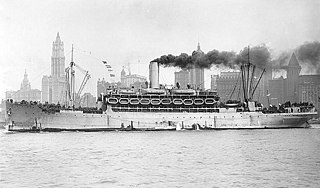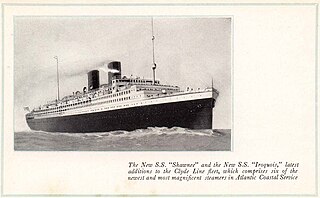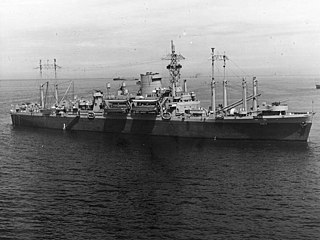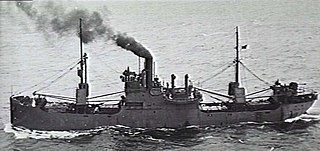
SS Borinquen, the Taino language name for Puerto Rico, was a passenger liner launched 24 September 1930 and delivered to the Atlantic, Gulf & West Indies Steamship Lines (AGWI) in 1931 for operation by its subsidiary the New York & Porto Rico Line. The line operated the ship until it was requisitioned by the War Shipping Administration (WSA) the last day of 1941 for service as a troop transport. The line then operated the ship as agent for the WSA until 6 May 1944 when operation was transferred to the United States Army for support of the Normandy landings with the ship arriving off the beaches on 7 June 1944. Borinquen continued service post war until redelivered to the owners 14 June 1946. The ship was sold in 1949 and became the Arosa Star. After further sales and change in the cruise ship regulations the ship was again sold and grounded as La Jenelle on the California coast in 1970.

Seatrain Lines, officially the Over-Seas Shipping Company, was a shipping and transportation company conducting operations in the Americas and trans-Pacific regions. Seatrain Lines began intermodal freight transport in December 1928 by transporting entire loaded railroad freight cars between the United States and Cuba. The specially designed ship Seatrain, built in England, was followed in 1932 by two larger ships built in the United States and in 1939 by two additional ships. By the outbreak of World War II the company was operating five ships that became important in the war effort and basis for the design of fifty new ships for military use. A series of business setbacks amid the rise of containerized shipping left the company in perilous financial condition in the 1970s. Seatrain Lines shut down in 1981 after filing for bankruptcy.

SS Munargo was a commercial cargo and passenger ship built for the Munson Steamship Line by New York Shipbuilding Corp., Camden, New Jersey launched 17 September 1921. Munargo operated for the line in the New York-Bahamas-Cuba-Miami service passenger cargo trade. In June 1930 the United States and Mexican soccer teams took passage aboard Munargo from New York to Uruguay for the 1930 FIFA World Cup. The ship was acquired by the War Shipping Administration and immediately purchased by the War Department for service as a troop carrier during World War II. Shortly after acquisition the War Department transferred the ship to the U.S. Navy which commissioned the ship USS Munargo (AP-20). She operated in the Atlantic Ocean for the Navy until returned to the War Department in 1943 for conversion into the Hospital ship USAHS Thistle.

USS Mizar (AF-12) was the United Fruit Company fruit, mail and passenger liner Quirigua that served as a United States Navy Mizar-class stores ship in World War II.

USS Talamanca (AF-15) was the United Fruit Company cargo and passenger liner Talamanca that served as a United States Navy Mizar-class stores ship in World War II.

USS Tarazed (AF-13) was the United Fruit Company cargo and passenger liner Chiriqui that was acquired by the United States Navy through a sub bareboat charter from the War Shipping Administration (WSA) which acquired the ship by bareboat charter from the company. The ship served as a Mizar-class stores ship in World War II. In peacetime before and after the war she carried fruit and passengers; in war she supplied troops and ships in the field. In 1958 she was sold to a German shipping line and renamed Blexen which was scrapped in 1971 after 39 years' service.

USS Merak (AF-21), the second Navy ship of the name, was the United Fruit Company cargo and passenger liner Veragua that served as a United States Navy Mizar-class stores ship in World War II.

USS George F. Elliott (AP-105) was a cargo liner built for the Mississippi Shipping Company as SS Delbrasil for operation between New Orleans and the east coast of South America in 1939 by its operator, Delta Line. The ship entered that service and operated until taken over by the War Shipping Administration (WSA) on 28 April 1942 for operation by Delta Line acting as WSA's agent. On 25 August 1943 WSA allocated the ship to the Navy for conversion to a troop transport commissioned and operated by the Navy for the duration of the war. Ownership of the ship was transferred from Mississippi Shipping to WSA on 4 February 1944 while under Navy operation and was retained until sale to American South African Lines on 22 December 1948. The ship was renamed African Endeavor until returned as a trade in to the Maritime Commission on 22 September 1960 for layup in the James River reserve fleet and later sold to Boston Metals for scrapping.

John L. Clem was built as the cargo and passenger liner Santa Ana for W. R. Grace and Company for service in Grace Line's South American service but was requisitioned before completion by the United States Shipping Board (USSB) in 1918 due to World War I. The ship was chartered back to Grace after completion until turned over to the United States Navy to be briefly commissioned as the troop transport USS Santa Ana (ID-2869) from 11 February 1919 to 21 July 1919.

SS Manchuria was a passenger and cargo liner launched 1903 for the San Francisco-trans Pacific service of the Pacific Mail Steamship Company. During World War I the ship was commissioned 25 April 1918–11 September 1919 for United States Navy service as USS Manchuria (ID-1633). After return to civilian service the ship was acquired by the Dollar Steamship Line in 1928 until that line suffered financial difficulties in 1938 and ownership of Manchuria was taken over by the United States Maritime Commission which chartered the ship to American President Lines which operated her as President Johnson. During World War II she operated as a War Shipping Administration transport with American President Lines its agent allocated to United States Army requirements. After World War II, she was returned to American President Lines, sold and renamed Santa Cruz. The liner was scrapped in Italy in 1952.

The Type C4-class ship were the largest cargo ships built by the United States Maritime Commission (MARCOM) during World War II. The design was originally developed for the American-Hawaiian Lines in 1941, but in late 1941 the plans were taken over by the MARCOM.
USNS Sgt. Joseph E. Muller was a C1-M-AV1 cargo ship completed 9 June 1945 and delivered to the War Shipping Administration (WSA) as Check Knot. After operation by WSA's agent Waterman Steamship Company June 1945 – November 1946 and being placed in reserve the ship was transferred to the U.S. Army and renamed USAT Sgt. Joseph E. Muller. She was transferred to the United States Navy in 1950 after the establishment of the Military Sea Transportation Service under Navy and assigned to Korean War supply and transport operations. She was again place back in service in 1962 as one of the civilian crewed, Auxiliary General (AG), technical research ships working on National Security Agency/Naval Security Group missions, based out of Florida. She was finally declared surplus to needs in 1969 and struck.

SS Aquarama was built as Marine Star, one of five breakbulk cargo ships of the United States Maritime Commission (USMC) type C4-S-B5 having that C4 design variant. The ship was delivered to the War Shipping Administration (WSA) for operation in July 1945 just before the end of World War II and was operated until August 1946 by WSA's agent American Hawaiian SS Company. From September 1947 the ship was laid up except for brief periods in the James River.

USAHS Marigold was a United States Army hospital ship during World War II. The ship was built as Old North State in 1920 for the United States Shipping Board as a civilian passenger/cargo liner. The ship changed ownership and operating companies several times with name changes to President Van Buren and President Fillmore before being acquired for military transport service in 1941. After government acquisition during World War II President Fillmore served as a War Shipping Administration troop transport before conversion to hospital ship service.

Shawnee was a passenger steam turbine-powered ship built in 1926-1927 by Newport News Ship Building & Drydock Co. of Newport News for Clyde Steamship Company, a subsidiary of Atlantic, Gulf & West Indies Steamship Lines with intention of operating between New York and southern ports of the United States. During the World War II the liner was requisitioned by the US Government, and served as the United States Army Transport from September 1942 to March 1946 in the Atlantic, Mediterranean and Pacific. Following the end of the war, the ship was sold to a Portuguese company and renamed City of Lisbon, and subsequently resold to Yugoslavia, becoming Partizanka operating with the shipping company Jugoslavenska Linijska Plovidba until 1949 when the steamer burned while in drydock and was declared a total loss.

SS Antigua was a United Fruit Company passenger and refrigerated cargo liner completed as one of six nearly identical vessels, three built by Newport News Shipbuilding and three by Bethlehem Shipbuilding Corporation, for operation by the company's subsidiary the United Mail Steamship Company. The ship was the first of the ships built by Bethlehem Shipbuilding Corporation, Quincy, Massachusetts.
SS Haiti was a passenger and freight ship built for the Colombian Mail Steamship Company built at Newport News Shipbuilding, Newport News, Virginia and delivered 15 December 1932. The ship was renamed briefly Puerto Rico in 1938 and Monterey in 1939 to operate for the New York and Cuba Mail Steamship Company until requisitioned with transfer of title to the War Shipping Administration (WSA) on 25 September 1942. The ship was then allocated to the U.S. Army for operation under a bareboat agreement as USAT Monterey. In 1943 the ship was assigned to the command at Trinidad to supply bases in Brazil and Ascension Island. After layup in the reserve fleet the ship was sold to Turkey.

Corvus was a steam cargo ship built in 1919 by Columbia River Shipbuilding Company of Portland for the United States Shipping Board as part of the wartime shipbuilding program of the Emergency Fleet Corporation (EFC) to restore the nation's Merchant Marine. The freighter was operated on international and domestic routes through 1944. Early in 1945 she was transferred to Soviet Union as part of lend-lease program and renamed Uzbekistan. After several months of operation, the freighter was rammed by another vessel on 31 May 1945 and was beached to avoid sinking. She was subsequently raised and towed to Portland where she was scrapped in 1946.

SS Panama was laid down 25 October 1937 as hull number 1467, launched on 24 September 1938 and completed 22 April 1939 at Bethlehem Shipbuilding Corporation in Quincy Massachusetts. The ship was given the official number 238343 and was owned and operated by the Panama Railroad Company. The ship was built for 202 single class passengers with a crew of 124. Panama was sister ship to USS Ancon and SS Cristobal.

SS Lake Elsmere was an Emergency Fleet Corporation (EFC) Design 1074 cargo ship built for the United States Shipping Board (USSB) during the massive shipbuilding effort of World War I.


















